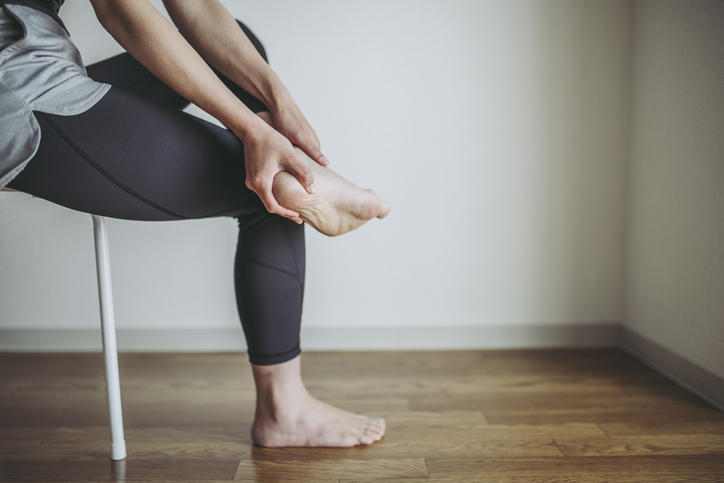
Whether you’re stepping onto the court, field, or your favorite running route, you’re scoring a win by making exercise part of your day. But with physical activity comes risk of injury, regardless of your fitness level.
What are some common sports injuries, and why do they happen? You may also be wondering about preventing injury or what to do if you become injured. Summit Health podiatrist Amanda Borrelli, DPM offers some answers and advice.
Common Sports Injuries
Dr. Borrelli’s experience includes treating sports injuries, and, as a member of Summit Health’s Podiatry team, she sees some of the most common ones: ankle sprains, Achilles tendon injuries, fractures, and heel pain.
- “Ankle sprains are one of the most common sports-related injuries we see,” she says. An ankle sprain occurs when one or more ligaments is stretched or torn, resulting in pain, swelling, and difficulty bearing weight. The most common ankle sprain is known as an inversion or lateral sprain, which happens when a misstep causes the ankle to roll inward, damaging the ligaments on the outside of the ankle and leading to ankle instability in severe cases.
- Achilles tendon injuries typically are associated with overuse, according to Dr. Borrelli. The Achilles tendon runs down the back of your lower leg, connecting your calf muscle to the heel bone. Repetitive activity involving this tendon can cause inflammation known as Achilles tendonitis, resulting in pain and tenderness. Achilles tendonitis can progress to a degeneration of the tendon over time if left untreated.
- Fracture means a broken bone in simplest terms, although there are many types of fractures. One type that Dr. Borrelli often sees in active individuals is a stress fracture, which occurs when repetitive pressure to the bones of the foot causes tiny cracks to form. While other fractures can cause immediate symptoms, a stress fracture can be a slow burn. “The pain typically builds gradually,” Dr. Borrelli says. “Patients will notice pain that worsens with activity, as well as swelling and tenderness to the area.” If left untreated, a stress fracture can lead to a complete break.
- Heel pain can have many causes, such as stress fracture or nerve damage, but plantar fasciitis most often is to blame. Plantar fasciitis occurs when the plantar fascia, the band of tissue that supports the arch of your foot, becomes inflamed. Sharp heel pain is the most common symptom, according to Dr. Borrelli, noting that “pain is worse with the first steps in the morning and after long periods of standing or walking throughout the day.” Like other sports injuries, overuse is a culprit, as is improper footwear.
Tips for Preventing Sports Injuries
Whether you’re starting or returning to activity, a weekend warrior, or consistently active, Dr. Borrelli offers the following tips for preventing common sports injuries:
- Stretch. It’s one of the best ways to prevent injury, and Dr. Borrelli advises incorporating stretching into your warm-up and cool-down.
- Wear the right shoes. When it comes to preventing foot and ankle injuries especially, size and wear and tear matter: Ill-fitting and heavily worn shoes can increase your risk of injury. “It’s important that your sneakers not only have good arch support, but also are the correct size,” Dr. Borrelli says. “If the tread or soles of your shoes are beginning to wear, it’s time for a new pair,” she added. If you have a history of ankle sprains, supportive gear such as an ankle brace also can be helpful.
- Listen to your body. Building in a rest day is a good idea even when you’re feeling 100 percent, and more rest is wise if you feel like something’s off. “Don’t push through the pain,” Dr. Borrelli says. “If your feet are in pain, it may mean you need to take time off.”
Treating Injuries When They Happen
Despite the attention given to stretching, proper footwear, training, and technique, a sports injury still can happen unfortunately. Depending on the injury and recommended treatment, recovery can take a few days or several weeks and months.
Most minor sports injuries can be managed at home. One at-home approach is the “RICE” protocol: Rest, which may include not putting weight on the injured body part; Ice to reduce pain and swelling; Compression to help with swelling and support; and Elevation of the affected area. Over-the-counter oral nonsteroidal anti-inflammatory drugs (NSAIDs), such as ibuprofen, also can help.
Other nonsurgical treatments include immobilization for stress fractures, or stretching exercises and prescription shoe inserts known as orthotics for Achilles tendon injuries and plantar fasciitis. If conservative treatments such as these fall short, surgery may be necessary.
Seeking expert advice early is your best game plan, whether it’s for conservative treatments including physical therapy, or for surgery. “Don’t wait too long to seek help,” Dr. Borrelli says. “Prompt evaluation and treatment are key to ensure proper healing and prevention of a longstanding injury.”
Overuse or overexertion, as well as improper training or technique, can sideline you from any activity—other common sports injuries include tennis elbow, herniated disc, and knee injuries, among others. Prevention and recognizing when you should see a doctor are important steps to staying and getting back in the game. “The sooner intervention is performed, the faster we can get you back on your feet,” Dr. Borrelli says.
